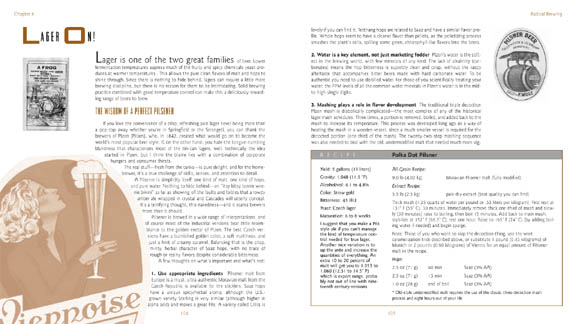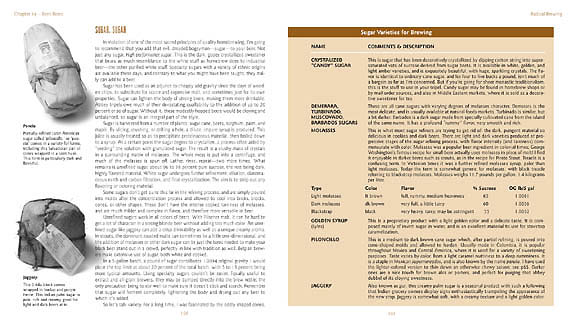SAMPLE SNIPPETS FROM RADICAL BREWING
All text Copyright 2004, Randy Mosher All rights reserved/
From the Foreword, The Marvel of Mosher, by Michael Jackson:
The world desperately needs more Moshers. If only we had more Moshers, the Tasmanian tiger might return from extinction. Mike Tyson at his peak would be able to step into the ring with Muhammed Ali. We would be able to see and hear the great performers who pre-dated the recording of sound. I might even now be sipping a pre-Prohibition beer and checking whether Buddy Bolden could be heard across Lake Ponchartrain. Or I might be sampling Harwood's Porter in a London pub, or an India Pale Ale aboard a clipper heading for Calcutta.
From the Introduction:
We're taught from childhood that what is good can't be fun. It's a lie. Homebrewing combines good and fun into one sparkling amber liquid. We can all drink to that.
Okay, so it isn't saving-babies-in-Africa good, but American homebrewers have profoundly changed the beer scene for the better. What we've accomplished, along with making it pretty easy to get a palatable beer just about anywhere in this country, is nothing less than keeping beer, a twelve thousand year-old cultural treasure of humanity, from slipping into a coma of mechanized industrial anonymity.
Beer is a deep, wide river that flows through human culture. It appears along with the earliest signs of civilization, and is enjoyed and venerated in nearly every society with access to its makings. To think that might have been subsumed into the drab one-size-fits-all world of the modern commerce is an outrage, but we came very close. Fortunately, things are on a happier track now.
From Chapter 1, An Embellished History of Beer:
A Mostly True Beer History Timeline
10,000 B.C.E. Glaciers melt, barley pops up everywhere. Neolithic people take flat rocks and pound it into hearty nourishing gruel.
9999 B.C.E Neolithic people sick of gruel. Wonder what else they can do with barley.
9998-9000 B.C.E. Tried everything: gruel loaf, gruel au jus, gruel fritters, gruel pate, gruel in aspic. Charred meat is still by far the most popular food.
8999 B.C.E. Final contestant in barley cook-off comes up with a winner: crock-aged festering sprouted barley-cake bisque with bitter herbs, actually much more enjoyable than it sounds. Dubbed beer, it's much better than gruel. The formerly neglected Goddess of Gruel becomes fashionable new Goddess of Beer, now in big demand at parties everywhere across Fertile Crescent.
From Chapter 3, An Overview of Brewing:
Brewing is no more difficult than making lasagna. If you can whip up this noodley melange, then you can make terrific beer. Limits on time, space, or money need not stop you. All you really need is desire.
You will start with an extract-plus-grain beer, using fresh hops and a little crystal malt for flavor. The procedure is simple. It will take you a couple of hours, plus about a month of waiting.
Some shops will try to sell you a can of extract and 3 pounds of corn sugar. Run for the door! This vile mixture will create a thin, screechy half-beer, diluted with pure alcohol. If you want horrible beer, there's plenty on the grocery store shelves; no point in brewing it. Malt, not sugar, gives beer its flavor. Sugar has a place in brewing, as you will see. But not like this.
From Chapter 7, Basic Drinkers:
If beers could talk, many of the blondest would sound like this: "Hi, I'm like, oooh..you're so...heehee...giggle."
Poor darlings. Cast off like orphans by thoughtless brewpubbers who fling them in the tanks at the last minute "to make the partners happy," or to placate those pitiful customers who "don't know what good beer is," blonde ales all too frequently are perceived to lack deep inner beauty. This is a shame, because blonde beers can be as deeply soulful as their brunette cousins, just as worthy of a lustful, longing well-informed gaze. So, fellow homebrewers, it is up to us, as usual, to take things into our own hands, and brew beer the way it is supposed to be.
From Chapter 8, Lager On:
The stereotype of Germany is of a country where everything fits into scrupulously tidy compartments, utterly regulated, suiting the tastes of the residents like a pair of custom- fitted lederhosen. I've heard brewers there bemoan the situation that brewing a beer outside of well-established styles is not only frowned upon, but in some cases simply not permitted.This is belied by a strong interest in such Americana as free jazz and the artistic oeuvre of David Hasselhoff. And if you look carefully, you might see an eccentric beer that slips outside the carefully constructed framework of allowable brews. Black, roasty, caramelly schwarzbier is such a product.
From Chapter 10, Big Honkin Brews:
Dragon's Milk: English October Beer
It's the stuff of legend, the muse of poets, the nectar of the gents. Strong beer, brilliant as topaz, sweet as dew, and dripping with the perfume of hops, was for centuries a revered icon of English culture. In typical language-loving English style these beers were nicknamed angel's-food, clamber-skull, huffcap, and more.
October beer was the most laudable product of country brewing, specifically country house brewing. Beer wasn't a readily transportable product in the oxcart era, so the maintenance of an estate, large or small, required beer to be brewed on the premises.
From about 1600 to 1900, there were four classes of beers brewed on estates, although not all kinds were brewed by every brewer. On the bottom was weak and watery small beer, usually the last runnings of whatever was being brewed, although occasionally brewed on its own in summer months. Next up the scale in strength was "table" beer, what we today would regard as ordinary strength, roughly in the 1.050 (12 P) (4.5-percent alcohol) range. Next was March and October beer at about 1.080 (19 P), followed by rarely brewed "double" beers, well over 1.100 (24 P) (9-percent plus), and reserved for special occasions (see p 135).
From Chapter 12, Hops Are Just Another Herb, Mon:
In the long, broad history of beer, the hop is a relative newcomer. Hops began to be used in beer about 1100 C.E. in Europe, and much later in the British Isles. For a few centuries, herbed beers existed side-by-side with hopped beers before they were superseded by more modern fashion and banned by edicts such as the Reinheitsgebot.
Many lingered on until fairly recently. During the nineteenth century, spiced beers still lived, albeit in the margins. Heather ale was being brewed in the hills of Scotland; an anise beer called "swankey" was made in Pennsylvania; rustic spiced country brews were slowly winking out in England.
Some survive to this day. A cloudy, delicately spiced Belgian wheat beer called "wit" vanished for a few decades, then was resurrected. In Berlin, the local wheat beer, a light, yogurty brew called weisse, is still commonly served with a dash of syrup made from an herb called woodruff, while in the same region other spiced white ales such as gose and kotbuss still linger. North into Scandinavia, strong, juniper-tinged beers provide a delicious link to the past for the enthusiastic cartetakers of the style.
From Chapter 14, Bent Beers:
In violation of one of the most sacred principles of quality homebrewing, I'm going to recommend that you add that evil, dreaded bogeyman--sugar--to your beer. Not just any sugar. High-performance sugar. This is the dark, gooey crystallized sweetener that bears as much resemblance to the white stuff as homebrew does to industrial beer--the other purified white stuff. Specialty sugars with a variety of ethnic origins are available these days, and contrary to what you might have been taught, they really can add to a beer.
From Chapter 17, Forward Into The Past:
A number of different grains were available to ancient peoples, including two-, four-, and six-row barleys; emmer and einkorn wheat; spelt; and various types of millet. Some of these grains made pretty lousy bread, and were undoubtedly used for brewing. There's a four-thousand-year-old cake of coarse barley on display in the Oriental Institute in Chicago, so rough it makes your gums bleed to look at it. Such cakes were a preliminary step to brewing, thankfully, so the ancients wouldn't have had to pick the husks from their teeth, and used a more tender grain for their daily bread.
In addition to fermentables from grain, other sources of fermentable sugars existed in the form of dates, grapes, figs, palm sugar, honey, and other minor sources.
On Danziger Jopenbier:
First, a thin white film of mold formed, then changed to bluish green, which accounted for the first two weeks. Then, bubbling gas started coming up from the wort and broke up the film, which, in turn, further sped up the fermentation. This proceeded very vigorously for ten to fourteen days, and provisions needed to be made to retain and return the overflow to the fermenter. In the third phase, the yeast kind of settled out. Then another film formed on the surface--white at first, then dark brown, then at last green, growing and thickening, folding itself up into great ridges as it floated on the surface.
From Chapter 19, Save the Bees:
Many scholars believe mead may have been the first fermented beverage. And the fact that the same Indo-European root word, medhu, means "honey," "sweet," and "drunkenness" is further evidence for this. Honey won't ferment in its natural concentrated form, but as soon as it is diluted--when combs are washed out, for example--it starts to ferment. There is, in fact, no ancient technology capable of stopping it more than temporarily. With no cooking or crushing needed, it's the simplest alcoholic beverage to make, and probably appeared just as soon as humans created something to put it in. The rock art of one Neolithic society, at Tassili-n-Ajjer in Algeria, prominently features a zoomorphic "bee-man," which is suggestive of their familiarity with the other sort of buzz that bees create. Never mind the fact that he is covered head-to-toe with magic mushrooms as well.
This buzz is not always simply from alcohol. Many plants with toxic and/or psychoactive components exude them in their nectar, which is then concentrated by the bees into a kind of narcotic honey that Pliny the Elder called meli moenomenon, or "mad honey." Datura, belladonna, cannabis, wild rosemary, rhododendron, and a large number of tropical plants are capable of producing mind-altering honey, and the ethnobotanical connections for many psychoactive honeys are well documented. Fortunately, such honeys are rare, and pose little danger (or opportunity) for mad meadmakers.
From Chapter 21, A few Words on Beer and Food:
One should not overwhelm the other. Find beers of the same intensity as the food. A salad obviously needs a lighter accompaniment than a steak.
Look for resonance. See if you can find similar flavors in the food and beer that can play off each other and add up to a greater whole--pairing a spicy dunkelweizen with a delicately spiced gingerbread, for example. Or to ramp it up, maybe a weizenbock with a sauerbraten in its traditional gingersnap gravy. There are lots of possibilities: toasted savory flavors, buttery richness, herbal or spicy aromas, creamy textures, smokiness, and roasted chocolate flavors. The list goes on and on.
Do a balancing act in your mouth. Everything's going to end up there anyway, so consider the food and beer as one thing, not two. Once you match the intensity, you can find foods and beers that will play off each other's eccentricities. A remarkable example of this is to pair a sweet carrot cake with a crisply bitter imperial India pale ale. They have a similar intensity, but one is very sweet, the other intensely bitter. A mouthful of one demands a swig of another, and on and on it goes.

